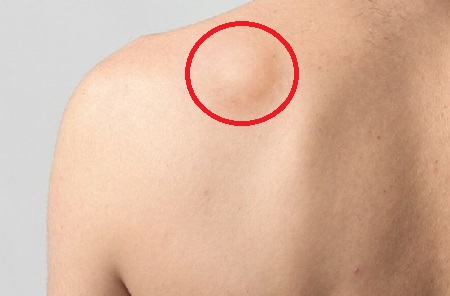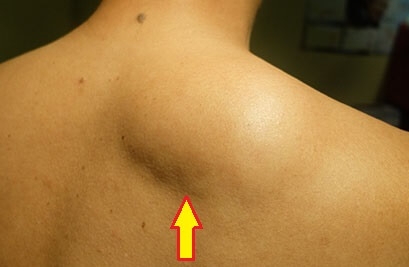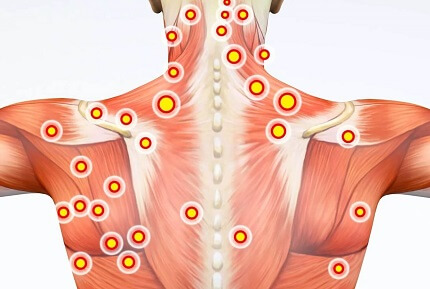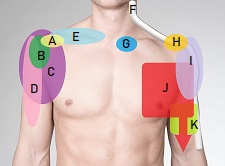- Home
- Diagnosis Guide
- Lump On Arm
- Lump Behind Shoulder
Lump On Back Of Shoulder
Written By: Chloe Wilson BSc (Hons) Physiotherapy
Reviewed By: SPE Medical Review Board

There are lots of possible causes of a lump on the back of the shoulder, but in most cases it is nothing serious.
There may be anything from a hard lump on the back of the collarbone to a soft lump by the shoulder blade or a tight, a painful knot in the muscle to fast growing lump.
Shoulder lumps may be caused by excess fluid, a problem in one of the bones, a shoulder injury, a benign growth or an infection.
Here we will look at both the common and rarer causes of a lump on the back of the shoulder, what causes them, the common symptoms of each and how to work out what is going on. We will then go on to look at the best treatment options for lumps and bumps on the back of the shoulder.
Common Causes Of Bumps On The Back Of The Shoulder
Let’s start by looking at the four most common causes of a lump on the back of your shoulder and how to treat them.
1. Shoulder Cysts
The most common cause of a lump on the back of the shoulder is a cyst.
Shoulder cysts are closed sacs or pockets of tissue that can be filled with fluid, pus or other material. Shoulder cysts are benign (non-cancerous) bumps on the back of the shoulder and don’t tend to cause any problems, other than sometimes being unsightly.
There are a few different types of cyst that can cause a bump on the back of the shoulder:
- Ganglion Cysts: are filled with thick jelly-like synovial fluid and extend out from one of the shoulder joints or tendon sheaths. They can vary in size from 0.5cm-4cm diameter and are usually painless
- Epidermoid Cysts: form when cells from the top layer of skin (epidermis), including the protein keratin, multiply abnormally and become trapped beneath the skin surface. An epidermoid cyst lump on back of shoulder usually feels soft but firm and may have a blackhead in the centre
- Sebaceous Cysts: form from blocked hair follicles or oil glands in the skin and are typically filled with a cheesy or oily substance. A sebaceous bump on back of shoulder is usually soft and mobile
In most cases, a lump on the back of the shoulder from a cyst doesn’t require any treatment unless it is encroaching on surrounding structures and causing pain or restricted motion. Shoulder cyst treatment may then involve a combination or rest, ice, medication, aspiration (draining the fluid), corticosteroid injections or occasionally surgery.
You can find out loads more about how cysts cause lumps on the back of the shoulder, the different types of cysts and the best ways to treat them in the Shoulder Cyst section.
2. Lipoma

Another common cause of a lump on the back of the shoulder is a lipoma.
Lipomas are benign (non-cancerous) growths of fatty tissue that typically develop just below the skin.
A lipoma lump on the back of the shoulder typically feels soft and doughy to touch. Lipoma lumps are usually mobile, meaning they move easily with slight pressure and are typically painless.
Lipomas are usually slow-growing and can vary in size, ranging from small pea-sized lumps to larger growths, several centimetres in diameter.
The exact cause of a lipoma bump on the back of the shoulder is not always clear, but they are thought to result from an overgrowth of fat cells. Risk factors such as family history, genetics and being middle-aged may increase the chance of developing lipomas.
3. Muscle Knots

Muscle knots, aka myofascial trigger points, are a common cause of painful lumps on the back of the shoulder.
Trigger points are sensitive areas within muscle tissue that can cause tenderness, pain, stiffness, tightness and discomfort. Muscle knots often feel like a firm nodule or lump underneath the skin.
When you press on a muscle knot, you may feel a taut band, palpable nodule or lump within the affected muscle. These areas are often hypersensitive and may elicit a twitch response or radiating pain when pressure is applied.
Trigger points often develop due to overuse, repetitive movement, poor posture, muscle imbalance or trauma. They can also be associated with stress, tension, dehydration, inadequate rest, or underlying medical conditions.
Muscle knots can occur in any muscle of the body but most commonly cause lumps on the back of the shoulder in the trapezius, rhomboids and levator scapulae muscles.
Treatment for muscle knot lumps on the back of the shoulder may include manual techniques such as massage, trigger point release aka myofascial release and acupuncture. Posture correction, heat therapy, stretching exercises and strengthening exercises also really help.
You can find out more about the common causes, symptoms, diagnosis and treatment in the Trapezius Pain & Trigger Points section.
4. Trauma
If you have a lump on the back of your shoulder following an injury, there are several possible explanations:
- Fracture: if the injury is severe, such as a fall or direct blow to the shoulder, it’s possible that a fracture (broken bone) could occur. In some cases, a fracture may result in a visible or palpable lump at the injury site, particularly if there is displacement of the bone fragments. The most common shoulder fractures to result in a lump on the back of the shoulder are clavicle fractures and shoulder blade fractures.
- Dislocation: dislocations at the shoulder occur when one of the bones pops out of its normal position, typically following a fall, direct blow or motor-vehicle accident. A lump on the back of the shoulder from a dislocation is usually very obvious and can occur at the shoulder (glenohumeral) joint where the upper arm bone pops out of the shoulder socket, or at the acromioclavicular joint where the collarbone shifts away from the shoulder socket.
- Haematoma: a lump may form on the back of the shoulder following an injury due to a hematoma if blood vessels are damaged and there is bleeding into the surrounding tissues. The blood pools forming a spongy, rubbery lump that may be red, blue, black or purple in colour.
- Soft Tissue Injury: injuries such as muscle strain, ligament sprain and tendon tears can also result in swelling and the formation of a lump on the back of the shoulder
If you develop a visible or palpable bump or lump on the back of your shoulder following an injury, get checked out by your doctor as soon as possible.
Other Causes Of Lumps Behind The Shoulder
There are some other, less common causes of a lump on the back of the shoulder:
- Winging Scapula: where the shoulder blade (scapula) protrudes or “wings” away from the back due to weakness or dysfunction of the muscles that stabilise it against the rib cage. Scapular stabilisation exercises are one of the best ways to treat winging scapula
- Swollen Lymph Node: a lump on the back of the shoulder may be an enlarged lymph node which is usually associated with a bacterial or viral infection e.g. common cold or ‘flu. Swollen lymph nodes usually settle down with 2 weeks. Find out more >
- Bone Spurs: aka osteophytes are bony outgrowths that develop when excess bone is laid down, either due to wear or tear or following a fracture. A hard bump on the back of the shoulder from a bone spur is usually associated with clavicle fractures, arthritis or ACJ injuries
- Abscess: a localised collection of pus forms within tissues due to a bacterial infection. Bacteria enter through a break in the skin, multiply and trigger an immune response. This can lead to a firm, red, warm, painful lump on back of shoulder that may be associated with fever, chills and pus leaking from the lump. The abscess may need to be drained before being treated with antibiotics
- Lymphoma: a rare type of blood cancer that affects the immune system. A lymphoma lump on the back of the shoulder is usually painless and accompanied by other symptoms such as unexplained weight-loss, severe night sweats, fever and fatigue. Urgent medical review is necessary with suspected lymphoma
- Melanoma: a type of skin cancer that often presents as either a new mole or an existing mole that changes size, shape, colour or texture. A melanoma lump on the back of the shoulder is often asymmetrical with jagged, blurred or uneven borders and rather than being an even colour like a normal mole, typically contains shades of brown, black or tan, or occasionally pink or red
- Synovial Sarcoma: a rare type of malignant tumor that can develop in any soft tissue around the shoulder forming a slow growing, typically painless lump. Usually affects young adults aged 15-40
Diagnosing Lumps On The Back Of The Shoulder
Most of the time, a lump the back of your shoulder is nothing serious and will often settle down on its own, but it is important to get any new lump checked out by your doctor, especially if you have any of the following symptoms:
- Feeling Unwell: fever, fatigue, night sweats, unexplained weight loss
- Lump Is Changing: growing rapidly, changing shape or texture, or is very large
- Injury: if the lump appeared after an injury e.g. fall
- Limited Range Of Motion: if your shoulder or arm movements are significantly restricted
Your doctor will start by taking a history, asking you about your symptoms, your medical history and normal activities. They will then examine your shoulder, looking at both the lump behind your shoulder and your shoulder and arm movements and muscle strength. They may also send you for additional tests such as a CT or MRI scan, ultrasound or a biopsy if they suspect something sinister.
You may also be interested in the following articles:
Treatment For Bumps Behind The Shoulder
Treatment for a lump on the back of the shoulder will depend on the underlying cause so it is important to get an accurate diagnosis from your doctor to determine the most appropriate treatment.
- Shoulder Cyst Treatment: rest, ice medication, aspiration (draining the fluid), corticosteroid injections, exercises or occasionally surgery. Most shoulder cysts don’t require any treatment unless they are causing pain. Find Out More >
- Shoulder Lipoma Treatment: lipomas don’t normally require any treatment unless they are painful, large or in an obvious place in which can they can be surgically removed
- Muscle Knot Treatment: heat, stretches, strengthening exercises, massage, myofascial release, posture re-education. Find Out More >
- Shoulder Injury Treatment: treatment will depend on the type and extent of injury
- Winging Scapula Treatment: typically benefit from scapular stabilisation exercises
- Bone Spur Treatment: often don’t require treatment, but may benefit from strengthening and stretching exercises
- Shoulder Abscess Treatment: drainage of the abscess and antibiotics
- Malignant Tumour Treatment: specialist treatment required depending on the type and extent of the malignancy
Lump On Back Of Shoulder Summary
There are lots of possible causes of a lump on the back of the shoulder, most of which are not serious.
The most common causes of lumps and bumps behind the shoulder are cysts, benign growths, muscle knots and shoulder injuries.
Occasionally, a lump behind the shoulder may be something more serious, but is usually accompanied by other symptoms such as feeling unwell, fatigue, fever, night sweats or unexplained weight loss – if you have any of those symptoms see your doctor as soon as possible.
In many cases, you can adopt a wait and watch approach but if the lump on the back of your shoulder starts causing pain, restricts movement or changes shape or size, seek medical attention.
You may also be interested in the following articles:
Related Articles
Shoulder Problems
September 26, 2023
Diagnosis Charts
September 28, 2023
Rehab Exercises
December 12, 2023
Medical & Scientific References
Journal of Shoulder & Elbow Surgery. Subacromial Lipoma Causing Impingement Syndrome Of The Shoulder: A Case Report
National Library Of Medicine: Myofascial Trigger Points Then And Now: A Historical & Scientific Perspective
NIH: Evaluation Of Bone And Soft Tissue Tumors Of The Shoulder Girdle
Page Last Updated: May 2nd, 2024
Next Review Due: May 2nd, 2026


